![]()
NOTES ON ISSUE 1: GLOSSARY
Now, what I want is Facts. Teach
these boys and girls nothing but Facts. Facts alone are wanted in life. Plant
nothing else, and root out everything else. You can only form the minds of reasoning
animals upon Facts: nothing else will ever be of any service to them. This is
the principle on which I bring up my own children, and this is the principle
on which I bring up these children. Stick to Facts, sir!
The scene was a plain, bare, monotonous vault of a school-room…
In the opening passage of Hard Times, we meet one of its central characters,
Mr. Gradgrind, and hear his own description of his philosophy, as applied to
child-rearing and education. Gradgrind's emphasis on "nothing but Facts"
signals his adherence to Utilitarianism, which is a major target for Dickens
in Hard Times. Nineteenth-century Utilitarian thinkers, the best known
of whom was Jeremy Bentham (1748-1832), privileged empiricism and reason, focusing
on quantifying human behavior to produce "the greatest good for the greatest
number." The character of Thomas Gradgrind takes these tendencies to an
extreme. In the school he sponsors, he prohibits all speculation, fancy, and
play, and the driest of lessons are given to the pupils. In the period before
the 1854 composition of Hard Times, Victorian society struggled with
the question of how to provide comprehensive elementary education to all children.
Private schools such as Gradgrind's were common. Early plans for widespread
education, undertaken without government sponsorship, resulted in competing
plans such as the Lancasterian schools, run on the monitorial system, and Samuel
Wilderspin's infant schools, which emphasized play and freedom for young children.
The Lancasterian system had a strong influence on later nineteenth-century education.
A classroom that strongly resembles the "plain, bare, monotonous vault
of a school-room" that Dickens describes in the passage above is pictured
below:
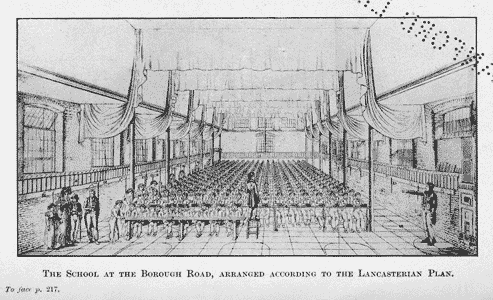
This illustration, "The School at Borough Road, Arranged
According to the Lancasterian Plan," from C. Birchenough's History of
Elementary Education in England and Wales from 1800 to the Present Day (1914).
Samuel Wilderspin's infant schools, on the other hand, were a freer, more playful
environment, as shown in this very different illustration from Birchenough's
History of Elementary Education:
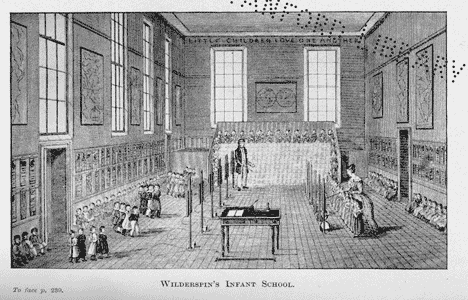
In 1846—eight years before Dickens wrote Hard Times—the British government assumed a more active role in education. Sir James Kay-Shuttleworth (1804-77), a Utilitarian educator in Manchester, proposed and became the director of a new government-supported system that emphasized factual education and standardized teacher training. The principles described in the opening of Hard Times may be modeled to some degree on Kay-Shuttleworth's work. Although Dickens admired some of Kay-Shuttleworth's achievements, he disliked his emphasis on Utilitarian education.
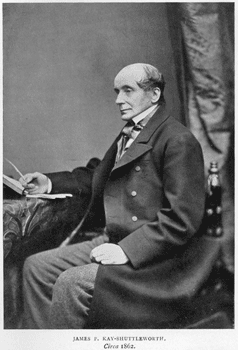
This 1862 portrait of James Kay-Shuttleworth is taken
from Frank Smith's Life and Work of Sir James Kay-Shuttleworth (1923).
with a system to force down the general throat like
a bolus…
A bolus is a large pill.
To continue in fistic phraseology, he had a genius
for coming up to the scratch
Before the Queensberry Rules were introduced in 1867,
boxing was conducted bare-knuckled, according to the London rules. The "scratch"
was a line drawn in the ring, from which the fighters started. If the fighter
could not get to the scratch without help at the beginning of each round, he
lost the fight.
He would go in and damage any subject whatever with
his right, follow up with his left, stop, exchange, counter, bore his opponent
(he always fought All England) to the ropes, and fall upon him neatly.
All England or London rules for boxing permitted fighters to push their opponents
up against the ropes, using their own weight. "Bore" is thus used
in a double sense here, as a boxing metaphor and in the literal sense of the
"third gentleman" making dull, boring speeches to defeat "all
England"—also used in a double sense.
You are not, Mary Jupe…
Dickens considered naming Sissy "Mary," and the inconsistency here
stands in the Household Words text. It was corrected in later editions.
You are not to have, in any object of use or ornament,
what would be a contradiction in fact. You don't walk upon flowers in fact;
you cannot be allowed to walk upon flowers in carpets. You don't find that foreign
birds and butterflies come and perch upon your crockery; you cannot be permitted
to paint foreign birds and butterflies upon your crockery…. This is fact.
This is taste.
In these declarations on taste, Dickens is satirizing
the Department of Practical Art, established as part of the Board of Trade in
1852, which made similar pronouncements on the role of realism in tasteful interior
design. Dickens had no objection to using flowers and other "contradictions
in fact" in decoration—a penchant that he shared with Victorian culture
as a whole.
Despite the best Gradgrindian efforts of the Department of Practical Art, representational
decoration flourished at the time. Just three years before Dickens wrote Hard
Times, for instance, the Great Exhibition at the Crystal Palace had afforded
manufacturers the opportunity of showing off their vast range of patterned carpets,
furniture, and other items both useful and decorative. Engravings of some of
the exhibits in the Illustrated London News show a number of flower-patterned
carpets.

This engraving of a "patent power-loom printed carpet by Messrs. Bright and Co." appeared in the September 6, 1851, issue of the Illustrated London News.
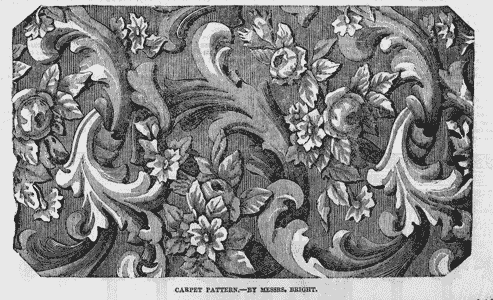
This engraving of another carpet pattern, also by Bright
and Co., appeared in the August 2, 1851, issue.
Mr. M'Choakumchild
The teacher Mr. M'Choakumchild is essentially a briefly seen caricature, as
indicated by his unrealistic name, but aspects of his name and personality refer
to contemporary figures and philosophical debates. The Scottish "M'"
(more familiarly rendered as "Mc") at the beginning of his name underscores
the degree to which educational theory at the time, as well as Utilitarian thought,
was derived from Scottish thinkers.
Moreover, Dickens may have had two Scotsmen—both named McCulloch—in mind as
loose models when he chose the name. The lesser-known, J.M.M. M'Culloch, was
a headmaster at an Edinburgh school and wrote practical and dry textbooks. The
second, J. R. McCulloch, was a well-known political economist and statistician.
In the wake of the public dismay after the publication of Thomas Malthus's Essay
on the Principle of Population (1806), McCulloch "embarked on a lifelong
campaign to improve the public image of political economy," according to
Mary Poovey in A History of the Modern Fact. Poovey continues:
By rewriting the history of the discipline, creating a canon for political economy, making reliable texts of the Wealth of Nations available for the first time, and placing political economy at the center of countless educational schemes, McCulloch sought to popularize the science that Malthus had rendered so disagreeable. McCulloch was not completely successful in resuscitating political economy, of course; opponents of the manufacturing system, like Dickens and Carlyle, simply turned their venom from Malthus to McCulloch and continued to lament the end of moral knowledge.
Stone Lodge was situated on a moor within a mile
or two of a great town—called Coketown in the present faithful guide-book.
"Coketown" is Dickens's substitute for a northern manufacturing town,
generally assumed to be Manchester, but probably combining aspects of that city
with Birmingham and other cities as well. Dickens's decision to fictionalize
the setting of the novel was an unusual one for him; the novels he set in London
are characterized by a great specificity of place. But Dickens did not know
the industrial north well, and he wished to avoid offending the denizens of
any one city. The mention of Stone Lodge's situation "on a moor" clearly
places the city in the north of England. It was common for well-to-do businessmen
from such towns to live slightly out of town, in order to escape the smoky air
and poor sanitation of the town center.
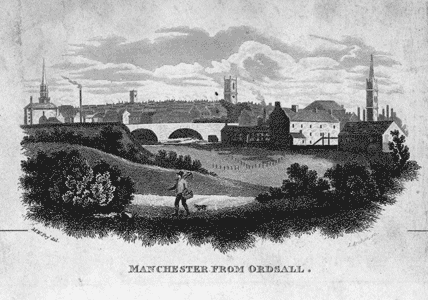
This view of Manchester from Ordsall, a short distance away,
is a detail taken from an 1824 map of the city center; the small view illustrates
a corner of the map. By 1824, 30 years before the publication of Hard Times,
Manchester was already well established as an industrial center.
The little Gradgrinds had cabinets in various departments
of science, too. They had a little conchological cabinet, and a little metallurgical
cabinet, and a little mineralogical cabinet; and the specimens were all arranged
and labelled…
Collecting and arranging specimens from natural history, such as shells, or
metals and minerals, was a popular pursuit for the scientifically minded in
the nineteenth century, though it was usually associated with educated gentlemen
rather than children.
the highly novel and laughable hippo-comedietta
of the Tailor's Journey to Brentford
A hippo-comedietta is a short circus comedy, performed on horseback. "The
Tailor's Journey to Brentford," first performed in 1768, was actually performed
at Astley's Royal Amphitheatre in 1853-4.
Phenomenon almost incredible though distinctly seen,
what did he then behold but his own metallurgical Louisa, peeping with all her
might through a hole in a deal board, and his own mathematical Thomas abasing
himself on the ground to catch but a hoof of the graceful equestrian Tyrolean
flower-act.
Dickens takes the opportunity here, as Mr. Gradgrind discovers his children
trying to watch the circus, for a sly jab at Utilitarian lingo: Mr. Gradgrind,
much against his will, is forced to believe the "distinctly seen"
evidence of his own eyes. The circus's "graceful equestrian Tyrolean flower-act"
(performed, as we are told earlier, by Miss Josephine Sleary) may be based on
various equestrian acts, many performed by one Louisa Woolford, that Dickens
saw and enjoyed in his youth.

Harry French depicts Sleary and Josephine, in her costume as an equestrienne (but not on horseback) in a plate from the Household Edition of Hard Times. The flowers in her costume may refer to the "Tyrolean flower-act."

This illustration, taken from the Illustrated London News
of September 13, 1845, shows a female equestrian, Madame Klatt, performing at
Astley's Royal Amphitheatre.
Not being Mrs. Grundy, who was Mr. Bounderby?….
He was a rich man: banker, merchant, manufacturer, and what not. A big, loud
man, with a stare, and a metallic laugh. A man made out of a coarse material,
which seemed to have been stretched to make so much of him…. A man who
could never sufficiently vaunt himself a self-made man…
Mr. Bounderby—"banker, merchant, manufacturer, and what not"—is
Dickens's representative in Hard Times of the wealthy industrialists
of the northern manufacturing towns of England. Many of the manufacturers of
the era were involved in a number of ventures, including banking, as a way to
consolidate their wealth and improve their business. Bounderby's very name,
incorporating as it does the suggestion that he is a "bounder" or man on the
make, is indicative of his character.
Despite Bounderby's wealth, it would have been well understood by Victorian
readers that he ought not to be considered a gentleman—even before they were
to see the depiction of him bragging of his humble origins. Manufacturers, being
"in trade" rather than university-educated men who practiced a profession (or
had no need to do so), were not seen as particularly genteel. (This point also
comes up in Elizabeth Gaskell's North and South, another of many industrial
novels of the 1840s and 1850s.) Nevertheless, the idea of the self-made man,
which Bounderby exploits in his bragging, was an important Victorian myth, famously
expressed in Samuel Smiles's Self-Help, published in 1857. Although Bounderby
has climbed the social and economic ladder far above his self-proclaimed origins,
Dickens's depiction leaves readers in no doubt as to his vulgarity.
that brassy speaking-trumpet of a voice of his
A speaking-trumpet was a megaphone, used to increase the sound of the voice.
It was often used on board ships.
"She kept a chandler's shop," pursued Bounderby,
"and kept me in an egg-box."
Chandler's shops were originally places that sold candles, but had gradually
become small general grocers, usually kept by women and found especially in
poorer areas.
studying the steeple clock of St. Giles's Church,
London, under the direction of a drunken cripple
In the early nineteenth century—the period of Bounderby's youth—the district
surrounding St. Giles's Church in London, near Charing Cross Road and Shaftesbury
Avenue, was a criminal haunt and slum. (St. Giles is the patron saint of the
poor and crippled.) Much of the parish was demolished between 1844 and 1847,
and the infamous Seven Dials area was reconstructed as New Oxford Street. Bounderby
is thus using a reference to this notoriously disreputable area to underscore
his reverse pedigree.
Mrs. Gradgrind's stock of facts in general was woefully
defective; but Mr. Gradgrind, in raising her to her high matrimonial position,
had been influenced by two reasons. Firstly, she was most satisfactory as a
question of figures…
Dickens is here implying that Mrs. Gradgrind comes from a wealthy background,
and brought plenty of money to her marriage with Mr. Gradgrind. Under Victorian
law, all of the wife's property automatically became the husband's upon marriage.
(Under some circumstances, the family of a wealthy bride could and did skirt
this law by creating trusts that provided some financial security for the wife
or her children in case of the husband's death.) A wife could not legally own
any property, retain money for her own use, or keep wages she earned until after
the passage of the Married Women's Property Act in 1870.
Adam Smith and Malthus, two younger Gradgrinds
The two little Gradgrinds are both named for well-known political economists.
Adam Smith (1723-90) was the author of The Wealth of Nations and is often
considered the father of laissez-faire capitalist thinking. Thomas Malthus (1766-1834)
is best known for his work on the question of overpopulation, the 1798 Essay
on the Principle of Population, a controversial work that caused a public
reaction against political economy.
Coketown, to which Messrs. Bounderby and Gradgrind
now walked, was a triumph of fact… It was a town of red brick, or of brick
that would have been red if the smoke and ashes had allowed it; but as matters
stood it was a town of unnatural red and black like the painted face of a savage.
It was a town of machinery and tall chimneys, out of which interminable serpents
of smoke trailed themselves forever and ever, and never got uncoiled. It had
a black canal in it, and a river that ran purple with ill-smelling dye, and
vast piles of building full of windows where there was a rattling and a trembling
all day long…
Dickens's Coketown, a northern cotton-manufacturing city, is generally assumed
to be Manchester, but he was somewhat more familiar with Birmingham than with
the former city. Although Dickens toured Manchester and other northern towns—and
had visited the town of Preston during its long strike, just months before the
publication of Hard Times began—he did not have the intense knowledge
of and identification with any of the northern cities that he did with London.
An 1824 map of Manchester and a nineteenth-century map of Birmingham (exact
date unknown) give a sense of the layout of each city.
The general description of an industrial Hell that Dickens creates for Coketown are, however, based on an amalgam of the several such cities Dickens had visited, and have a good deal of allegorical power, as in the image of "interminable serpents of smoke." The industrial towns were certainly smoky, as shown in this view of Manchester from the Illustrated London News of August 20, 1842.
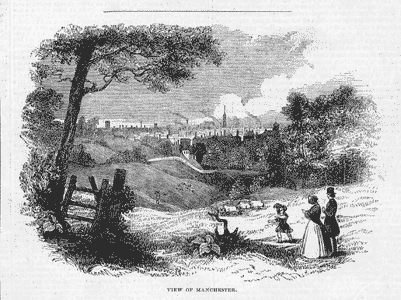
they lived upon the best, and bought fresh butter,
and insisted on Mocha coffee, and rejected all but prime parts of meat, and
yet were eternally dissatisfied and unmanageable.
Although in this passage the "gentlemen" of Coketown assert that the
working class had access to the best foodstuffs and were dissatisfied in spite
of it, the truth is quite different. Many workers could afford little to eat
besides bread. Fresh butter, for instance, was all but unobtainable for the
poor; instead, when they could afford it, they bought cheaper (and older) salted
butter, preserved in casks. Mocha coffee is a high-quality type that was also
unaffordable for the working classes; imports of coffee were highly taxed, and
as a consequence the poor drank coffee that was mixed with the cheaper chicory.
Moreover, the adulteration of food was common in Victorian times. Coffee, for
instance, might be cut with various burnt or roasted items, such as corn. Tea
was similarly meddled with or the leaves resold after being used. Flour for
bread was eked out with chalk or alum. Mrs Beeton's Book of Household Management
(1861) offers a rather casual aside: "The commonest adulterations of milk
are not of a hurtful character. It is a good deal thinned with water, and sometimes
thickened with a little starch, or coloured with yolk of egg, or even saffron;
but these processes have nothing murderous in them." More harmful adulterations
included the use of poisonous red lead to color certain foods.
People who lived in the country or who had access to fresh foods from farms
were not as subject to the vagaries of the commercial food supply as Victorian
city dwellers. But those who were less well off, in particular, could not be
confident in the purity or quality of the food they ate.
"What have you got in that bottle you
are carrying? "Gin," said Mr. Bounderby. "Dear, no, sir! It's
the nine oils."
Gradgrind's question, and Bounderby's assumption that Sissy Jupe is carrying
a bottle of gin for her father, are typical of certain middle-class stereotypes
of lower- or working-class habits in the mid-nineteenth century. Gin was considered
a distinctly lower-class drink, available in disreputable "gin palaces"
and thought to go hand in hand with other vices of the poor. The middle and
upper classes were more likely to drink wine and fortified wines such as port
and sherry.
Sissy's reply that she is carrying "the nine oils" seems to imply
that she is somewhat shocked at the idea that she might have gin with her. The
nine oils was a preparation mainly used in veterinary medicine, for treating
horses, but circus performers also used it to rub over bruises. According to
one nineteenth-century druggists' book, oils used in the preparation included
train oil, oil of turpentine, oil of bricks, oil of amber, spirit of camphor,
Barbadoes tar, and oil of vitriol.